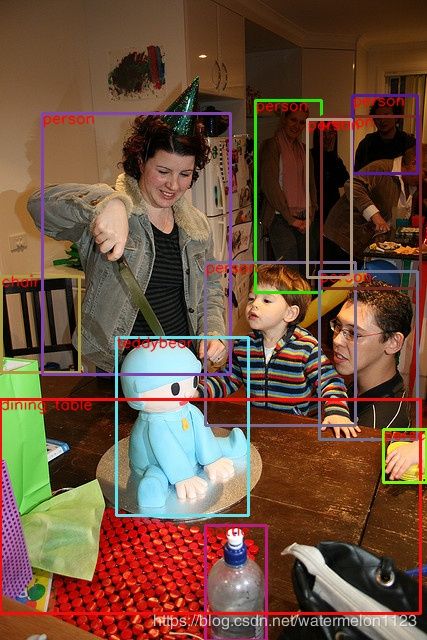利用Pytorch torchvision完成Faster-rcnn目标检测demo及源码详解
Torchvision更新到0.3.0后支持了更多的功能,其中新增模块detection中实现了整个faster-rcnn的功能。本博客主要讲述如何通过torchvision和pytorch使用faster-rcnn,并提供一个demo和对应代码及解析注释。
目录
如果你不想深入了解原理和训练,只想用Faster-rcnn做目标检测,请看这里
torchvision中Faster-rcnn接口
一个demo
使用方法
如果你想深入了解原理,并训练自己的模型
环境搭建
准备训练数据
模型训练
单张图片检测
效果
如果你不想深入了解原理和训练,只想用Faster-rcnn做目标检测,请看这里
torchvision中Faster-rcnn接口
torchvision内部集成了Faster-rcnn的模型,其接口和调用方式野非常简洁,目前官方提供resnet50+rpn在coco上训练的模型,调用该模型只需要几行代码:
>>> import torch
>>> import torchvision
// 创建模型,pretrained=True将下载官方提供的coco2017模型
>>> model = torchvision.models.detection.fasterrcnn_resnet50_fpn(pretrained=True)
>>> model.eval()
>>> x = [torch.rand(3, 300, 400), torch.rand(3, 500, 400)]
>>> predictions = model(x)
注意网络的输入x是一个Tensor构成的list,而输出prediction则是一个由dict构成list。prediction的长度和网络输入的list中Tensor个数相同。prediction中的每个dict包含输出的结果:
其中boxes是检测框坐标,labels是类别,scores则是置信度。
>>> predictions[0]
{'boxes': tensor([], size=(0, 4), grad_fn=), 'labels': tensor([], dtype=torch.int64), 'scores': tensor([], grad_fn=)} 一个demo
如果你不想自己写读取图片/预处理/后处理,我这里有个写好的demo.py,可以跑在任何安装了pytorch1.1+和torchvision0.3+的环境下,不需要其他依赖,可以用来完成目标检测的任务。
为了能够显示类别标签,我们将coco的所有类别写入coco_names.py
names = {'0': 'background', '1': 'person', '2': 'bicycle', '3': 'car', '4': 'motorcycle', '5': 'airplane', '6': 'bus', '7': 'train', '8': 'truck', '9': 'boat', '10': 'traffic light', '11': 'fire hydrant', '13': 'stop sign', '14': 'parking meter', '15': 'bench', '16': 'bird', '17': 'cat', '18': 'dog', '19': 'horse', '20': 'sheep', '21': 'cow', '22': 'elephant', '23': 'bear', '24': 'zebra', '25': 'giraffe', '27': 'backpack', '28': 'umbrella', '31': 'handbag', '32': 'tie', '33': 'suitcase', '34': 'frisbee', '35': 'skis', '36': 'snowboard', '37': 'sports ball', '38': 'kite', '39': 'baseball bat', '40': 'baseball glove', '41': 'skateboard', '42': 'surfboard', '43': 'tennis racket', '44': 'bottle', '46': 'wine glass', '47': 'cup', '48': 'fork', '49': 'knife', '50': 'spoon', '51': 'bowl', '52': 'banana', '53': 'apple', '54': 'sandwich', '55': 'orange', '56': 'broccoli', '57': 'carrot', '58': 'hot dog', '59': 'pizza', '60': 'donut', '61': 'cake', '62': 'chair', '63': 'couch', '64': 'potted plant', '65': 'bed', '67': 'dining table', '70': 'toilet', '72': 'tv', '73': 'laptop', '74': 'mouse', '75': 'remote', '76': 'keyboard', '77': 'cell phone', '78': 'microwave', '79': 'oven', '80': 'toaster', '81': 'sink', '82': 'refrigerator', '84': 'book', '85': 'clock', '86': 'vase', '87': 'scissors', '88': 'teddybear', '89': 'hair drier', '90': 'toothbrush'}
然后构建一个可以读取图片并检测的demo.py
import torch
import torchvision
import argparse
import cv2
import numpy as np
import sys
sys.path.append('./')
import coco_names
import random
def get_args():
parser = argparse.ArgumentParser(description='Pytorch Faster-rcnn Detection')
parser.add_argument('image_path', type=str, help='image path')
parser.add_argument('--model', default='fasterrcnn_resnet50_fpn', help='model')
parser.add_argument('--dataset', default='coco', help='model')
parser.add_argument('--score', type=float, default=0.8, help='objectness score threshold')
args = parser.parse_args()
return args
def random_color():
b = random.randint(0,255)
g = random.randint(0,255)
r = random.randint(0,255)
return (b,g,r)
def main():
args = get_args()
input = []
num_classes = 91
names = coco_names.names
# Model creating
print("Creating model")
model = torchvision.models.detection.__dict__[args.model](num_classes=num_classes, pretrained=True)
model = model.cuda()
model.eval()
src_img = cv2.imread(args.image_path)
img = cv2.cvtColor(src_img, cv2.COLOR_BGR2RGB)
img_tensor = torch.from_numpy(img/255.).permute(2,0,1).float().cuda()
input.append(img_tensor)
out = model(input)
boxes = out[0]['boxes']
labels = out[0]['labels']
scores = out[0]['scores']
for idx in range(boxes.shape[0]):
if scores[idx] >= args.score:
x1, y1, x2, y2 = boxes[idx][0], boxes[idx][1], boxes[idx][2], boxes[idx][3]
name = names.get(str(labels[idx].item()))
cv2.rectangle(src_img,(x1,y1),(x2,y2),random_color(),thickness=2)
cv2.putText(src_img, text=name, org=(x1, y1+10), fontFace=cv2.FONT_HERSHEY_SIMPLEX,
fontScale=0.5, thickness=1, lineType=cv2.LINE_AA, color=(0, 0, 255))
cv2.imshow('result',src_img)
cv2.waitKey()
cv2.destroyAllWindows()
if __name__ == "__main__":
main()
运行命令
$ python demo.py [image path]就能完成检测,并且不需要任何其他依赖,只需要Pytorch1.1+和torchvision0.3+。看下效果:
使用方法
我发现好像很多人对上面这个demo怎么用不太清楚,照着下面的流程做就好了:
- 下载代码:https://github.com/supernotman/Faster-RCNN-with-torchvision
- 下载模型:Baidu Cloud
- 运行命令:
$ python detect.py --model_path [模型路径] --image_path [图片路径]
其实非常简单。
如果你想深入了解原理,并训练自己的模型
这里提供一份我重构过的代码,把torchvision中的faster-rcnn部分提取出来,可以训练自己的模型(目前只支持coco),并有对应博客讲解。
- 代码地址:https://github.com/supernotman/Faster-RCNN-with-torchvision
- 代码解析博客:
Pytorch torchvision构建Faster-rcnn(一)----coco数据读取
Pytorch torchvision构建Faster-rcnn(二)----基础网络
Pytorch torchvision构建Faster-rcnn(三)----RPN
Pytorch torchvision构建Faster-rcnn(四)----ROIHead
- 训练模型:Baidu Cloud
环境搭建
下载代码:
$ git clone https://github.com/supernotman/Faster-RCNN-with-torchvision.git安装依赖:
$ pip install -r requirements.txt注意:
代码要求Pytorch版本大于1.1.0,torchvision版本大于0.3.0。
如果某个依赖项通过pip安装过慢,推荐替换清华源:
$ pip install -i https://pypi.tuna.tsinghua.edu.cn/simple some-package如果pytorch安装过慢,可参考conda安装Pytorch下载过慢解决办法(7月23日更新ubuntu下pytorch1.1安装方法)
准备训练数据
下载coco2017数据集,下载地址:
http://images.cocodataset.org/zips/train2017.zip
http://images.cocodataset.org/annotations/annotations_trainval2017.ziphttp://images.cocodataset.org/zips/val2017.zip
http://images.cocodataset.org/annotations/stuff_annotations_trainval2017.ziphttp://images.cocodataset.org/zips/test2017.zip
http://images.cocodataset.org/annotations/image_info_test2017.zip
如果下载速度过慢,可参考博客COCO2017数据集国内下载地址
数据下载后按照如下结构放置:
coco/
2017/
annotations/
test2017/
train2017/
val2017/模型训练
$ python -m torch.distributed.launch --nproc_per_node=$gpus --use_env train.py --world-size $gpus --b 4训练采用了Pytorch的distributedparallel方式,支持多gpu。
注意其中$gpus为指定使用的gpu数量,b为每个gpu上的batch_size,因此实际batch_size大小为$gpus × b。
实测当b=4,1080ti下大概每张卡会占用11G显存,请根据情况自行设定。
训练过程中每个epoch会给出一次评估结果,形式如下:
Average Precision (AP) @[ IoU=0.50:0.95 | area= all | maxDets=100 ] = 0.352
Average Precision (AP) @[ IoU=0.50 | area= all | maxDets=100 ] = 0.573
Average Precision (AP) @[ IoU=0.75 | area= all | maxDets=100 ] = 0.375
Average Precision (AP) @[ IoU=0.50:0.95 | area= small | maxDets=100 ] = 0.207
Average Precision (AP) @[ IoU=0.50:0.95 | area=medium | maxDets=100 ] = 0.387
Average Precision (AP) @[ IoU=0.50:0.95 | area= large | maxDets=100 ] = 0.448
Average Recall (AR) @[ IoU=0.50:0.95 | area= all | maxDets= 1 ] = 0.296
Average Recall (AR) @[ IoU=0.50:0.95 | area= all | maxDets= 10 ] = 0.474
Average Recall (AR) @[ IoU=0.50:0.95 | area= all | maxDets=100 ] = 0.498
Average Recall (AR) @[ IoU=0.50:0.95 | area= small | maxDets=100 ] = 0.312
Average Recall (AR) @[ IoU=0.50:0.95 | area=medium | maxDets=100 ] = 0.538
Average Recall (AR) @[ IoU=0.50:0.95 | area= large | maxDets=100 ] = 0.631
其中AP为准确率,AR为召回率,第一行为训练结果的mAP,第四、五、六行分别为小/中/大物体对应的mAP
单张图片检测
$ python detect.py --model_path result/model_13.pth --image_path imgs/1.jpgmodel_path为模型路径,image_path为测试图片路径。
代码文件夹中assets给出了从coco2017测试集中挑选的11张图片测试结果。
效果
Good Luck!
如果对你有用的话,请给代码一个star,谢谢!

